Another group of mushrooms are bracket or shelf fungi. They can be just as colorful as the mushrooms in the last post and are usually easier to find because they usually grow up off the ground on trees, stumps, and logs.
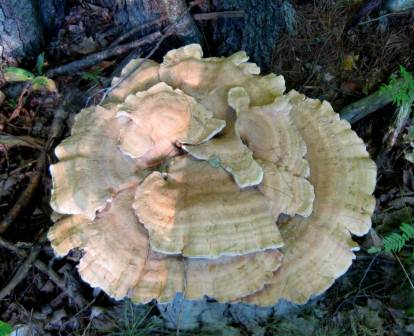 In my last post I told how I had stumbled upon the biggest mushroom I had ever seen, which was a chicken of the woods (Laetiporus Cincinnatus.) The very day that I wrote that, I found another chicken of the woods growing at the base of a tree not 10 feet from the road. This one was even bigger than the first-easily as big as a car tire-so I put a quarter on it to give you an idea of scale. You have to look closely-this one is so big that it makes the quarter look like a dime.
In my last post I told how I had stumbled upon the biggest mushroom I had ever seen, which was a chicken of the woods (Laetiporus Cincinnatus.) The very day that I wrote that, I found another chicken of the woods growing at the base of a tree not 10 feet from the road. This one was even bigger than the first-easily as big as a car tire-so I put a quarter on it to give you an idea of scale. You have to look closely-this one is so big that it makes the quarter look like a dime.  I think these are hairy stereum bracket fungi, also called hairy curtain crust (Stereum hirsutum.) The common name comes from the way these fungi are covered with fine hairs on their upper surface when young. As they age they lose the hairs and become smooth like other bracket fungi. Colors can vary but the hairs and very wavy edges help with identification. They like to grow on fallen deciduous trees and are one of the false turkey tail fungi. False turkey tail fungi are a polypore, which basically means they have pores instead of gills.
I think these are hairy stereum bracket fungi, also called hairy curtain crust (Stereum hirsutum.) The common name comes from the way these fungi are covered with fine hairs on their upper surface when young. As they age they lose the hairs and become smooth like other bracket fungi. Colors can vary but the hairs and very wavy edges help with identification. They like to grow on fallen deciduous trees and are one of the false turkey tail fungi. False turkey tail fungi are a polypore, which basically means they have pores instead of gills. 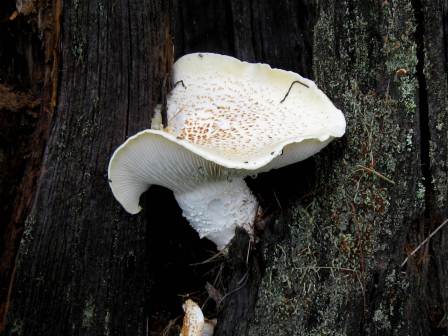 This mushroom was growing on a stump and it was quite large. I think it might be a tiger sawgill (Lentinus tigrinus.) Apparently the name refers to the scales on the cap that are supposed to resemble a tiger like pattern. Tigers have stripes and to me the scales look more like spots, so shouldn’t it be a leopard sawgill? The Lentus part of the scientific name means tough or pliant. When this mushroom grows on a living deciduous tree it causes white rot, and that means the tree is finished.
This mushroom was growing on a stump and it was quite large. I think it might be a tiger sawgill (Lentinus tigrinus.) Apparently the name refers to the scales on the cap that are supposed to resemble a tiger like pattern. Tigers have stripes and to me the scales look more like spots, so shouldn’t it be a leopard sawgill? The Lentus part of the scientific name means tough or pliant. When this mushroom grows on a living deciduous tree it causes white rot, and that means the tree is finished.  I think this might be another hairy stereum (Stereum hirsutum) bracket fungus just getting started. It’s interesting to see how it seems to flow out from under the bark almost as if it were liquid rather than solid. I’m not sure what its little friend wanted, but he might have been looking for some lunch.
I think this might be another hairy stereum (Stereum hirsutum) bracket fungus just getting started. It’s interesting to see how it seems to flow out from under the bark almost as if it were liquid rather than solid. I’m not sure what its little friend wanted, but he might have been looking for some lunch.  I think these might be white cheese polypores (Tyromyces chioneus.) This is another bracket fungus that causes white rot. They start life soft, watery, and velvety and then yellow slightly and become hard and smooth. When very old they look shriveled or wrinkled. Their common name comes from their scientific name- Tyromyces means “with a cheesy consistency,” and chioneus means “snow white.” I’m not sure if these had a cheesy consistency, but they were certainly snow white.
I think these might be white cheese polypores (Tyromyces chioneus.) This is another bracket fungus that causes white rot. They start life soft, watery, and velvety and then yellow slightly and become hard and smooth. When very old they look shriveled or wrinkled. Their common name comes from their scientific name- Tyromyces means “with a cheesy consistency,” and chioneus means “snow white.” I’m not sure if these had a cheesy consistency, but they were certainly snow white. 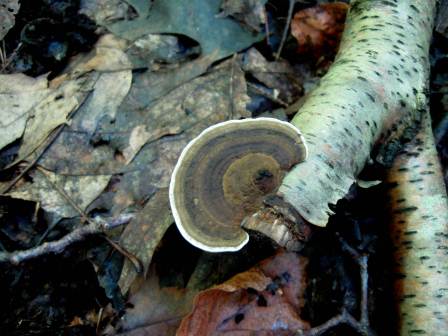 Some bracket fungi have gills on their undersides, some have pores, and some are “toothed” with many tiny spines. True turkey tail fungi (Trametes versicolor) have pores and false turkey tails have a smooth brown surface. That’s the easiest way to tell the two apart. The Stereum ostrea pictured here (I think) is a false turkey tail. These fungi live on hardwood logs and cause white rot. The one pictured here was quite young. Often age and even where the fungus grows will cause variations in size, shape and color in bracket fungi.
Some bracket fungi have gills on their undersides, some have pores, and some are “toothed” with many tiny spines. True turkey tail fungi (Trametes versicolor) have pores and false turkey tails have a smooth brown surface. That’s the easiest way to tell the two apart. The Stereum ostrea pictured here (I think) is a false turkey tail. These fungi live on hardwood logs and cause white rot. The one pictured here was quite young. Often age and even where the fungus grows will cause variations in size, shape and color in bracket fungi.  The thin dark strip before the white edge leads me to believe that this is a Ganoderma applanatum, which is called artist’s fungus, artist’s conk, or artist’s polypore. The art comes in when the white flesh is scratched and the scratches turn a light brown color. I have one that I drew a picture on over 30 years ago. I can’t be positive that’s what it is though because the colors vary so much and I didn’t test this one to see if its flesh was brown / cinnamon colored. This one was quite big-about the size of a dinner plate.
The thin dark strip before the white edge leads me to believe that this is a Ganoderma applanatum, which is called artist’s fungus, artist’s conk, or artist’s polypore. The art comes in when the white flesh is scratched and the scratches turn a light brown color. I have one that I drew a picture on over 30 years ago. I can’t be positive that’s what it is though because the colors vary so much and I didn’t test this one to see if its flesh was brown / cinnamon colored. This one was quite big-about the size of a dinner plate.  These look orange brown to me. Identifying them has proven much harder than it should be, but I think they might be another example of hairy stereum bracket fungi (Stereum hirsutum.) These fungi have such variable colors and shape that it’s hard to know for sure.
These look orange brown to me. Identifying them has proven much harder than it should be, but I think they might be another example of hairy stereum bracket fungi (Stereum hirsutum.) These fungi have such variable colors and shape that it’s hard to know for sure.  I got a little frustrated at not being able to see the colors of these fungi accurately so I just this minute found a shareware program called “What Color.” You just put the cursor on a color and it tells you what it is. So far, it seems accurate. In these turkey tails (Trametes versicolor) it sees tan, dark khaki, thistle (purple,) plum (darker purple,) light slate gray, olive green, dark sea green, steel blue, light steel blue, rosy brown, and sienna. That seems like an awful lot of colors. I think tan with light purple edges would do.
I got a little frustrated at not being able to see the colors of these fungi accurately so I just this minute found a shareware program called “What Color.” You just put the cursor on a color and it tells you what it is. So far, it seems accurate. In these turkey tails (Trametes versicolor) it sees tan, dark khaki, thistle (purple,) plum (darker purple,) light slate gray, olive green, dark sea green, steel blue, light steel blue, rosy brown, and sienna. That seems like an awful lot of colors. I think tan with light purple edges would do.  This bracket fungus reminds me of those old balloon tires with wide white walls. I think this might be called the red banded polypore (Fomitopsis pinicola.) If it is, the top reddish part of the fungus will become one in several bands of yellows, reds, orange-reds and finally black nearest the tree. Rust red is the band color farthest from the tree. Its white flesh turns yellow when bruised. Red banded polypore is said to grow on over 100 species of trees. Another very similar fungus is the resinous polypore (Ischnoderma resinosum)
This bracket fungus reminds me of those old balloon tires with wide white walls. I think this might be called the red banded polypore (Fomitopsis pinicola.) If it is, the top reddish part of the fungus will become one in several bands of yellows, reds, orange-reds and finally black nearest the tree. Rust red is the band color farthest from the tree. Its white flesh turns yellow when bruised. Red banded polypore is said to grow on over 100 species of trees. Another very similar fungus is the resinous polypore (Ischnoderma resinosum) 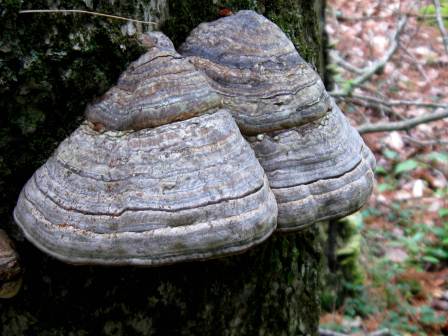 These horse hoof shaped fungi are called tinder polypore (Fomes fomentarius)because of their age old use as tinder to start fires. In the middle ages strips of these fungi were used in flintlock rifles. A spark from a flint would ignite the tinder polypore, which in turn would ignite the gunpowder. The Cree tribe of Native Americans also used these fungi to carry coals from one place to another. Tinder polypores produce huge amounts of spores; measurements in the field have shown that they release as many as 800 million spores per hour in the spring and summer! They grow on dead deciduous trees and logs. I found 30 or more marching up a dead maple one day.
These horse hoof shaped fungi are called tinder polypore (Fomes fomentarius)because of their age old use as tinder to start fires. In the middle ages strips of these fungi were used in flintlock rifles. A spark from a flint would ignite the tinder polypore, which in turn would ignite the gunpowder. The Cree tribe of Native Americans also used these fungi to carry coals from one place to another. Tinder polypores produce huge amounts of spores; measurements in the field have shown that they release as many as 800 million spores per hour in the spring and summer! They grow on dead deciduous trees and logs. I found 30 or more marching up a dead maple one day.  The shareware color finding program sees dark salmon pink in these turkey tails, along with greens, browns, and grays. I would have said brown with a white edge. Many of the turkey tails I saw last winter had a lot of purples and blues in them but so far this year they lean more toward browns and tans. I wish I could find information on what causes the colors in bracket fungi-I wonder if cold affects color.
The shareware color finding program sees dark salmon pink in these turkey tails, along with greens, browns, and grays. I would have said brown with a white edge. Many of the turkey tails I saw last winter had a lot of purples and blues in them but so far this year they lean more toward browns and tans. I wish I could find information on what causes the colors in bracket fungi-I wonder if cold affects color. 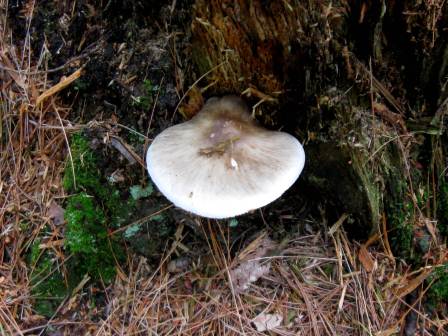 My color finding software says saddle brown nearest the tree, then 100% gray on the body, and then white on the outer edge. I can agree with that. I can’t find this mushroom in either of my books, which illustrates how sometimes the most common looking mushrooms are the hardest to identify.
My color finding software says saddle brown nearest the tree, then 100% gray on the body, and then white on the outer edge. I can agree with that. I can’t find this mushroom in either of my books, which illustrates how sometimes the most common looking mushrooms are the hardest to identify. 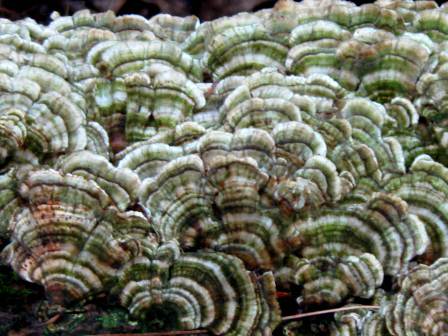 According to the color finding software the colors found in these are light blue, lavender, light steel blue, saddle brown, sea green, olive green, slate gray, light cyan, Alice blue, azure, tan, and sienna. I’m amazed how many colors can be found in turkey tails (Trametes versicolor.) And these are the plain ones!
According to the color finding software the colors found in these are light blue, lavender, light steel blue, saddle brown, sea green, olive green, slate gray, light cyan, Alice blue, azure, tan, and sienna. I’m amazed how many colors can be found in turkey tails (Trametes versicolor.) And these are the plain ones!
Nature alone is antique, and the oldest art a mushroom ~ Thomas Carlyle
Thank you for having a look.